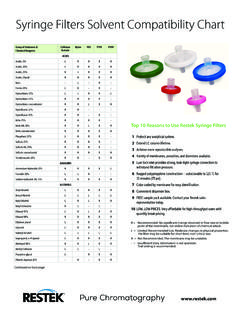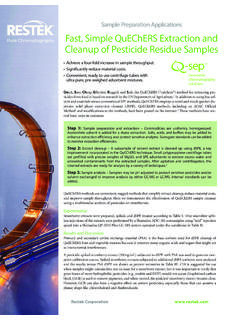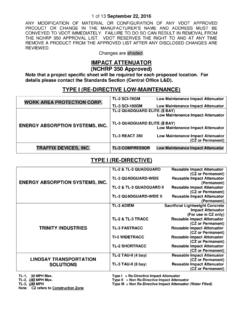Transcription of Why Derivatize? Improve GC Separations with …
1 Innovative clinical & forensics solutions Why Derivatize? Improve GC Separations with derivatization By Kristi Sellers, Innovations Chemist Get better Separations with increased resolution and response. Learn how to choose proper reagents for desired reactions. Many laboratories include derivatization as part of their sample preparation for gas chromatography (GC) analysis. So, what is derivatization ? Why is it important and how do you choose a derivatizing reagent? The discussion below answers these questions. By choosing the right derivatization reagent and procedure you can increase resolution and analyte response, significantly improving your Separations . What is derivatization ? derivatization is the process by which a compound is chemically changed, producing a new compound that has properties more amenable to a particular analytical method.
2 Some samples analyzed by GC require derivatization in order to make them suitable for analysis. Compounds that have poor volatility, poor thermal stability, or that can be adsorbed in the injector will exhibit nonrepro- ducible peak areas, heights, and shapes. Other compounds that respond poorly on a specific detector may need to be tagged with a different functional group to Improve detection. For example, tagging with chlorine can Improve response on an ECD (electron capture detector). In addition to improving suitability and response, derivatization can Improve resolution between coeluting com- pounds and overlapping How do I choose a derivatizing reagent? A good derivatizing reagent and procedure should produce the desired chemical modification of the compound(s) of interest, and be reproducible, efficient, and For GC, there are three basic types of derivatization reactions: silylation, acylation, and alkylation.
3 Silylating reagents react with compounds containing active hydrogens; these reagents are the most common type used in GC. Acylating reagents react with highly polar functional groups such as amino acids or carbohydrates. Alkylating reagents target active hydrogens on amines and acidic hydroxyl Multiple derivatizing reagents may be necessary for compounds contain- ing several different functional groups such as androsterone (Figure 1). In these multi-step derivatization procedures the use of other types of reagents, such as oxime, hydrazone, methylation, and cyclic derivatives, may be necessary. A multi-step example Figure 1 derivatization reaction of androsterone using TMSI/. derivatization can substantially Improve chro- methoxyamine. matographic results, as seen in this example deriva- tization of androsterone (Figure 1).
4 Androsterone contains a hydroxyl group and a carbonyl group and exhibits poor peak shape and poor separation if analyzed underivatized by GC (Figure 2b). Using silylation, active hydrogens on OH, SH, and NH. groups can be Since n-trimethylsilylimi- dazole (TMSI) is a strong silyl donor, it will react readily with the hydroxyl group on the andros- terone molecule creating a trimethylsilyl (TMS) derivative. Because androsterone also contains a carbonyl group, another derivatizing reagent is needed to Improve chromatographic peak shape. Methoxyamine will react with the carbonyl group forming an oxime derivative (CH3ON). Oxime derivatives not only Improve chromatographic performance, but also alter GC. Separations . Figure 2a shows the chromatographic result of derivatizing sex hormones using TMSI and methoxyamine.
5 Pure Chromatography retention times are increased, separation is Figure 2 Derivatized hormones show excellent resolution and increased, and peak shapes and responses are more symmetric peak shapes than underivatized hormones. improved. A) Derivatized hormones Conclusion Sample: 100 g/mL each hormone in methanol or ethanol; compounds Derivatizing compounds for GC often is necessary derivatized using 2% methoxylamine to obtain reproducible chromatographic results. HCl (CH3 ONH2) in pyridine, then TMSI. Eliminating this step to save time can be costly and 1. androsterone produce inaccurate and unreliable results. A well- 2. dehydroepiandrosterone (DHEA). 3. 17-a-estradiol chosen derivatization procedure, based on the 4. estrone chemical composition of the target compounds, 5.
6 17-b-estradiol 6. testosterone can significantly Improve your chemical separa- 7. derivatization by-product tions. References Low bleed at 300+ C! 1 Knapp D., Handbook of Analytical derivatization Reactions, Wiley- Interscience, 1979, , 449-453, 482. 2 3 Grob R., Barry E., Modern Practice of Gas Chromatography, Wiley- Interscience, 2004, pp. 817-818. GC_PH00872. B) Underivatized hormones Rxi -1ms Columns (fused silica). Sample: Sex hormones, 100 g/mL each, underivatized (Crossbond 100% dimethyl polysiloxane). 1 ID df ( m) temp. limits length cat. # -60 to 330/350 C 30-Meter 13323 6 Contact your Restek 2. representative and 5 order yours today! 3. 4. Visit min. to find a distributor or representative. GC_PH00923 min. Column: Rxi -1ms 30m, ID, m (cat.
7 # 13323). Inj.: L splitless (hold ), single gooseneck inlet liner (cat.# 20961). Inj. temp.: 250 C. Carrier gas: helium, constant flow Flow rate: 1mL/min. Oven temp.: 100 C to 320 C @ 10 C/min. (hold for 10 min.). Det.: MS: Shimadzu 17A with QP5000. Transfer line temp.: 280 C. Scan range: 40-700amu Ionization: EI. Mode: Scan Questions about this or any other Restek product? Contact us or your local Restek representative ( ). Restek patents and trademarks are the property of Restek Corporation. (See for full list.) Other trademarks in Restek literature or on its website are the property of their respective owners. Restek registered trademarks are registered in the and may also be registered in other countries. 2010 Restek Corporation. All rights reserved.
8 Printed in the Lit. Cat.# CFTS1269.
















